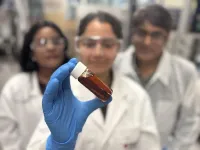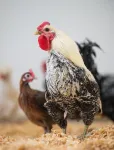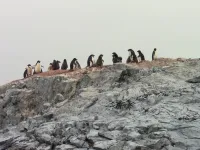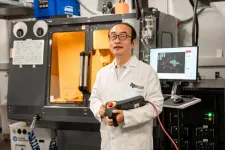(Press-News.org) Astronomers have peered back in time to find what looks like a population of 'hidden' galaxies that could hold the key to unlocking some of the universe's secrets.
If their existence is confirmed it would "effectively break current models of galaxy numbers and evolution".
The possible galaxies may also provide the missing piece of the puzzle for the energy generation in the universe in infrared light.
That's because their combined light would be enough to top-up the energy budget of the universe to the maximum we observe, effectively accounting for all remaining energy emission at these long wavelengths.
Possible evidence of the galaxies' existence was detected on the deepest ever image of the universe at long far-infrared wavelengths, which features almost 2,000 distant galaxies and was created by a team of researchers led by STFC RAL Space and Imperial College London.
Dr Chris Pearson, from STFC RAL Space, is lead author on one of two papers published today in Monthly Notices of the Royal Astronomical Society.
He said: "This work has pushed the science with Herschel to its absolute limit, probing far below what we can normally discernibly see and potentially revealing a completely new population of galaxies that are contributing to the very faintest light we can observe in the universe."
The team behind the research created their deep view of the universe by stacking 141 images on top of each other using data from the SPIRE instrument on the Herschel Space Observatory, a European Space Agency mission which ran from 2009 to 2013.
The resulting Herschel-SPIRE Dark Field is the deepest ever image of the far-infrared sky – five times deeper than the previous single deepest Herschel observation and at least twice as deep as any other area on the sky observed by the telescope.
Placing the images on top of each other allowed astronomers to see the dustiest galaxies, where most new stars are formed in the cosmos.
It also enabled them to track how the number of galaxies changes with brightness and to measure the contribution each one makes to the total energy budget of the universe.
However, the image was so deep and detected so many galaxies that the individual objects began to merge and become indistinguishable from each other.
This made extracting information challenging, according to Thomas Varnish, a PhD student at the Massachusetts Institute of Technology (MIT) and lead author on the second paper.
"We employed statistical techniques to get around this overcrowding, analysing the blurriest parts of the image to probe and model the underlying distribution of galaxies not individually discernible in the original image," said Mr Varnish, who carried out most of his research as a summer intern at Imperial College London and RAL Space.
"What we found was possible evidence of a completely new, undiscovered population of faint galaxies hidden in the blur of the image, too faint to be detected by conventional methods in the original analysis.
"If confirmed, this new population would effectively break all of our current models of galaxy numbers and evolution."
The researchers are now hoping to confirm the existence of the potential new group of galaxies using telescopes at other wavelengths.
Their aim is to decipher the nature of these faint, dusty objects and their importance in the grand scheme of the evolution of our universe.
Dr Pearson said: "When we look at starlight through normal telescopes, we are only able to read half of the story of our universe, the other half is hidden, obscured by the intervening dust.
"In fact, roughly half of the energy output of the universe is from starlight that has been absorbed by dust and re-emitted as cooler infrared radiation. To fully understand the evolution of our universe we need to observe the sky in both optical and longer wavelength infrared light."
The Herschel Space Observatory was tasked with observing the universe in the infrared, with its SPIRE instrument covering the very longest wavelengths.
Like any scientific instrument in space, the SPIRE instrument also required regular observations for calibration and routinely stared at a single patch of 'dark sky' every month or so, over the duration of its four-year mission.
Herschel held the record for the largest ever infrared space telescope, until it was eclipsed by the James Webb Space Telescope in 2021.
Imperial College London astrophysicist Dr David Clements, who was also involved in the research, added: "These results show just how valuable the Herschel archive is.
"We're still getting great new results more than 10 years after the satellite stopped operating.
"What we can't get, though, is more data at these wavelengths to follow up these fascinating new results. For that we need the next generation far-IR mission, PRIMA, currently being proposed to NASA."
The Probe far-Infrared Mission for Astrophysics (PRIMA) is being supported by a UK consortium including RAL Space, the University of Sussex, Imperial College London and Cardiff University.
It would involve the use of a 1.8-metre telescope optimised for far-infrared imaging and spectroscopy, bridging the gap between existing observatories such as the James Webb Space Telescope and radio telescopes.
PRIMA is one of two proposals shortlisted for NASA's next $1 billion (£772 million) probe mission. The US space agency will confirm its final mission selection in 2026.
ENDS
Media contacts
Sam Tonkin
Communications Officer
Royal Astronomical Society
Mob: +44 (0)7802 877 700
press@ras.ac.uk
Jake Hepburn
Press Officer
Science and Technology Facilities Council
Mob: +44 (0)7557 317200
Email: jake.hepburn@stfc.ac.uk
Eleanor Green
Science Communications Manager
Imperial College London
Tel: +44 (0)20 7594 9915
Email: e.green@imperial.ac.uk
Science contacts
Dr Chris Pearson
chris.pearson@stfc.ac.uk
STFC RAL Space
Dr Dave Clements
d.clements@imperial.ac.uk
Imperial College
Thomas Varnish
tvarnish@mit.edu
MIT
Video, images and captions
Herschel-SPIRE Dark Field
Caption: The final SPIRE Dark Field image map created by combining the Blue (250 micrometres), Green (350 micrometres) and Red (500 micrometres) SPIRE camera channels together, each channel stacking a total of 141 individual images on top of each other. The blobs on the image are all individual galaxies or groups of galaxies. However, the image is so crowded that there is almost no empty space with the faintest galaxies merging into the background light in the map.
Credit: Chris Pearson et al.
SPIRE Dark Field animation
Caption: The SPIRE Dark Field observed at different wavelengths (colours) moving from the shortest to the longest infrared wavelengths. The shorter wavelength images are from the Spitzer space telescope using the IRAC camera at 3.5 and 8 micrometres and the MIPS camera at 24 micrometres. These wavelengths are between 10-100 times short than the SPIRE observations and therefore appear sharper (higher resolution). The SPIRE images at 250, 250, 500 micrometres (and the final 250 + 350 + 500 combined RGB image) appear blurrier due to the lower resolution at the wavelengths, highlighting the challenges in identifying individual galaxies in the SPIRE maps. The green cross hair marks the same galaxy for reference in each of the images emphasising how different the sky looks at different wavelengths.
Credit: Chris Pearson et al. (Herschel), Krick et al. 2009 (Spitzer)
Further information
About SPIRE
The SPIRE instrument on Herschel was led by the UK with contributions from an international consortium.
The paper 'The Herschel-SPIRE Dark Field I' by Pearson et al. has been published in Monthly Notices of the Royal Astronomical Society. DOI: 10.1093/mnras/staf335
The paper 'The Herschel-SPIRE Dark Field II' by Varnish et al. has been published in Monthly Notices of the Royal Astronomical Society. DOI: 10.1093/mnras/staf318
For an advance copy of the papers, please email press@ras.ac.uk
Notes for editors
About the Royal Astronomical Society
The Royal Astronomical Society (RAS), founded in 1820, encourages and promotes the study of astronomy, solar-system science, geophysics and closely related branches of science.
The RAS organises scientific meetings, publishes international research and review journals, recognises outstanding achievements by the award of medals and prizes, maintains an extensive library, supports education through grants and outreach activities and represents UK astronomy nationally and internationally. Its more than 4,000 members (Fellows), a third based overseas, include scientific researchers in universities, observatories and laboratories as well as historians of astronomy and others.
The RAS accepts papers for its journals based on the principle of peer review, in which fellow experts on the editorial boards accept the paper as worth considering. The Society issues press releases based on a similar principle, but the organisations and scientists concerned have overall responsibility for their content.
Keep up with the RAS on Instagram, Bluesky, LinkedIn, Facebook and YouTube.
Download the RAS Supermassive podcast
About the Science and Technology Facilities Council (STFC)
The Science and Technology Facilities Council (STFC), part of UK Research and Innovation (UKRI), is the UK's largest public funder of research into particle and nuclear physics, astronomy and astrophysics, and space science. We operate five national laboratories across the UK which, supported by a network of additional research facilities, increase our understanding of the world around us and develop innovative technologies in response to pressing scientific and societal issues. We also facilitate UK involvement in a number of international research activities including CERN, the James Webb Space Telescope and the Square Kilometre Array Observatory.
END
'Hidden galaxies' could be smoking gun in universe riddle
2025-04-09
ELSE PRESS RELEASES FROM THIS DATE:
Love songs in the sand: researchers listen in to Fiddler crab courtship
2025-04-09
UNDER EMBARGO UNTIL 00:01 BST THURSDAY 10 APRIL / 19:01 ET WEDNESDAY 9 APRIL 2025
For the first time, a study led by University of Oxford researchers has ‘listened in’ to the fascinating courtship displays of Fiddler crabs using geophones. The findings, published today in the Journal of Experimental Biology, provide new insights into how the animals communicate effectively on the noisy seashore.
For male fiddler crabs, vibrational signals are a crucial part of their courtship routines – produced by drumming the ground using their oversized claw, ...
Study suggests lean muscle mass loss can be minimized during weight loss therapy using newer incretin obesity drugs
2025-04-09
New research to be presented at this year’s European Congress on Obesity (ECO 2025, Malaga, Spain, 11-14 May) shows that patients using GLP-1 or combined GLP-1 / GIP receptor agonist therapy for weight loss experienced minimal lean muscle mass loss as they lost weight across 6 months of treatment. The study is by Dr Dinabel Peralta-Reich, Donald and Barbara Zucker School of Medicine at Hofstra/Northwell; Lenox Hill Hospital, Northwell Health, New York City, NY, USA, and Dr Alexandra Filingeri, New York Weight Wellness Medicine, New York City, NY, USA, and colleagues.
GLP-1 (glucagon-like peptide-1) receptor agonists, ...
Aussie tech helps make bio-oils for greener industrial applications
2025-04-09
Australian technology developed at RMIT University could enable more sustainable and cheaper production of bio-oils to replace petroleum-based products in electronic, construction and automotive applications.
The technology, known as PYROCOTM, uses high temperatures without oxygen to convert treated sewage (biosolids) into a carbon-rich product called biochar, which can act as a catalyst to produce phenol-rich bio-oil.
PYROCOTM has been developed by RMIT in collaboration with South East Water, Intelligent Water Networks and other water authorities over several years and is now being applied to several exciting circular economy applications.
The RMIT team's latest research in collaboration ...
Map of genetic regulation in chickens could help fight against bird flu
2025-04-09
An international team of researchers led by Professor Huaijun Zhou from the UC Davis Department of Animal Science has created the first-ever detailed map of how genes are regulated in chickens — a breakthrough that could help scientists breed birds that are more resistant to diseases like avian influenza.
The study, published April 8 in Nature Genetics, brings together a massive amount of genetic and epigenetic data of more than 100 chicken breeds from around the world. The team, which ...
Scientists map unprecedented detail of connections and visual perception in the mouse brain
2025-04-09
What: In a massive scientific effort funded by the National Institutes of Health (NIH), hundreds of researchers have helped to map the connections between hundreds of thousands of neurons in the mouse brain and then overlayed their firing patterns in response to visual stimuli. This breakthrough is a critical piece of foundational science to build toward understanding how our brains process visual information to reconstruct the images we see every day.
Information processing in the human brain occurs ...
Mapping mercury contamination in penguins of the Southern Ocean
2025-04-09
In 1962, when environmentalist and author Rachel Carson penned Silent Spring, alerting the world to the dangers of the pesticide DDT, it was the reproductive threat to birds – the bald eagle in particular – that spurred people to action.
Six decades later, Rutgers University–New Brunswick researchers are taking the measure of another global environmental pollutant by drawing parallels to the crisis Carson identified. This time, the pollutant is mercury, and the sentinels are penguins living in the farthest reaches of the Antarctic Peninsula.
“With mercury, there’s an analogy to DDT,” said John Reinfelder, a professor in the Department of Environmental Sciences ...
Engineer aims to make giant leap for welding materials on the moon
2025-04-09
Before humans can colonize the moon or Mars, scientists and engineers must first develop techniques for building permanent structures and pressurized habitats in harsh, thin-atmosphere and low-gravity environments.
Dr. Wei Li, an assistant professor of mechanical engineering in the Erik Jonsson School of Engineering and Computer Science at The University of Texas at Dallas, is developing a virtual lunar welding platform to troubleshoot assembling large structures in such conditions.
“As we try to return to the ...
Tracking firearm violence and impact on dental health
2025-04-09
Higher firearm violence in neighborhoods is linked to lower rates of people going to the dentist and higher rates of total tooth loss, known as edentulism, according to Rutgers researchers.
Their study, published in the American Journal of Preventive Medicine, used data from the Centers for Disease Control and Prevention for dental care utilization and complete loss of teeth and data from the American Violence Project for firearm violence incidents. The researchers examined 20,332 census tracts within the 100 largest cities in the United States from 2014 to ...
3D streaming gets leaner by seeing only what matters
2025-04-09
A new approach to streaming technology may significantly improve how users experience virtual reality and augmented reality environments, according to a study from NYU Tandon School of Engineering.
The research — presented in a paper at the 16th ACM Multimedia Systems Conference on April 1, 2025 — describes a method for directly predicting visible content in immersive 3D environments, potentially reducing bandwidth requirements by up to 7-fold while maintaining visual quality.
The technology is being applied in an ongoing NYU Tandon National Science Foundation-funded project to bring point cloud video to dance education, making ...
How does heavy drinking affect the brain?
2025-04-09
EMBARGOED FOR RELEASE UNTIL 4:00 P.M. ET, WEDNESDAY, APRIL 9, 2025
MINNEAPOLIS — Heavy drinkers who have eight or more alcoholic drinks per week have an increased risk of brain lesions called hyaline arteriolosclerosis, signs of brain injury that are associated with memory and thinking problems, according to a study published on April 9, 2025, online in Neurology®, the medical journal of the American Academy of Neurology. The study does not prove that heavy drinking causes brain injury; it only shows an association.
Hyaline arteriolosclerosis is a condition that ...







